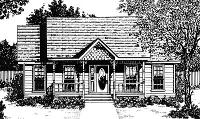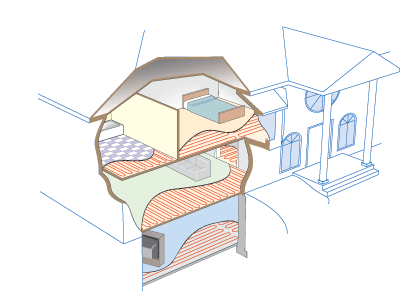Using a Water Heater for Space Heating Part 1We at Pexheat.com get asked this question a lot. I would like to take this chance to outline some of the important details worth considering when selecting a heat plant for your home, shop or business. After looking at these 5 points you should be able to determine if a water heater is applicable to your project.
These are only some of the detail you need to consider when selecting a heat source. But, if any of these don't eliminate a water heater as an option, then proceed to getting a detailed quote from your design engineer. Note: Most of the details in this article should be discussed with an experienced heating engineer to find the correct model. But I will give some "rules of thumb" so you can make an educated guess if a water heater can work for your project. |  |
In this article I will be using a small example project house designed for Long Island, NY with a full basement.
|  |
Heat Load / Flow ratesFirst things first. Will it work? Will the water heater do the job? You need to know the Heat Load on your heating system. Without that, you are just guessing. We at Pexheat do free heat loss calculations for all customers. However, to keep them free we just ask that you fill out one of our project specification forms found here; http://www.pexheat.com/Info/Estimate-Request. If you want to calculate your Heat Load yourself, you can approximate your Heat Load using these common load factors.
Multiply your load factors by the area being heated and you will get the Heat Load on your space.
Add up all the spaces to get the total approximated load on the heat plant.
Water Heaters and Boilers are sized by INPUT rating. That is how much fuel it burns. NOT how much heat it puts out. Another "rule of thumb" is to take the Input X Efficiency to get the OUPUT of the heater. If you are looking at water heaters, most tank style water heater burners max out at 30,000 to 40,000 BTU/hr INPUT. They are usually sold at 85% efficiency.
You can usually use a 40,000 BUT/hr burner to heat a 29,000 BTU/hr Load. So we can continue discussing the possibility of heating our example house with a water heater. Please see below for some recommendations on Load Only heater considerations.
What's this Flow Rate thing?Flow Rate is how fast we can move fluid through the pipes. All devices have flow rate characteristics where they resist higher and higher flows such that there is a maximum flow rate through the device. We need to consider the flow rate through the water heaters. Tank style water heaters, since they are just large tanks of water have very low flow resistance such that we can move relatively high rates through them. However, Tankless water heaters have heat exchangers in them with very high surface area. This is needed to move high amounts of heat into the fluid in short periods of time. This results in very low maximum flow rates.
So why do we care so much about flow? Flow is directly related to heat transfer. One can approximate the heat transfer of a heating system using another rule of thumb; Heat Transfer = Flow rate X 10,000 (at a 20 deg temperature change). Therefore, I can approximate the heat output of my Tankless water heaters at:
A Small 5 gpm Tankless water heater has enough capacity to heat my 29,000 BTU/hr project house too. Note: Even though the 5 gpm Tankless water heater may have been rated at 140,000 BTU/hr, we will only draw a maximum of 50,000 BTU/hr when used for space heating. |  |
Health & SafetyNow that we know we can heat the space with our water heater, we question should we heat it with a water heater. Is it safe to use a water heater as a space heater? Water heaters were designed to heat water for domestic hot water use. They were designed to heat up to 120-140 deg F and run for short periods throughout the day. If your heat demand falls into the design characteristics of a water heater then it may still be worth considering.
Our project house in Long Island can use a water heater for space heating under local building codes. Because the slab installations will require less than 140 deg. F water, it is safe to use a water heater to heat the radiant slabs. We will also be installing 2 separate water heaters; one to supply domestic hot water and a separate water heater to supply the radiant floor. |  |
| Brian Whitehurst is the Senior Design Engineer and Owner of Pexheat.com a radiant floor heating design and sales company operating since 2002. | |
| See Part 2 to Look at Efficiency and Cost |
Pexheat.com, Brian Whitehurst
September 24, 2021
Tags
Archive
Sign in to leave a comment